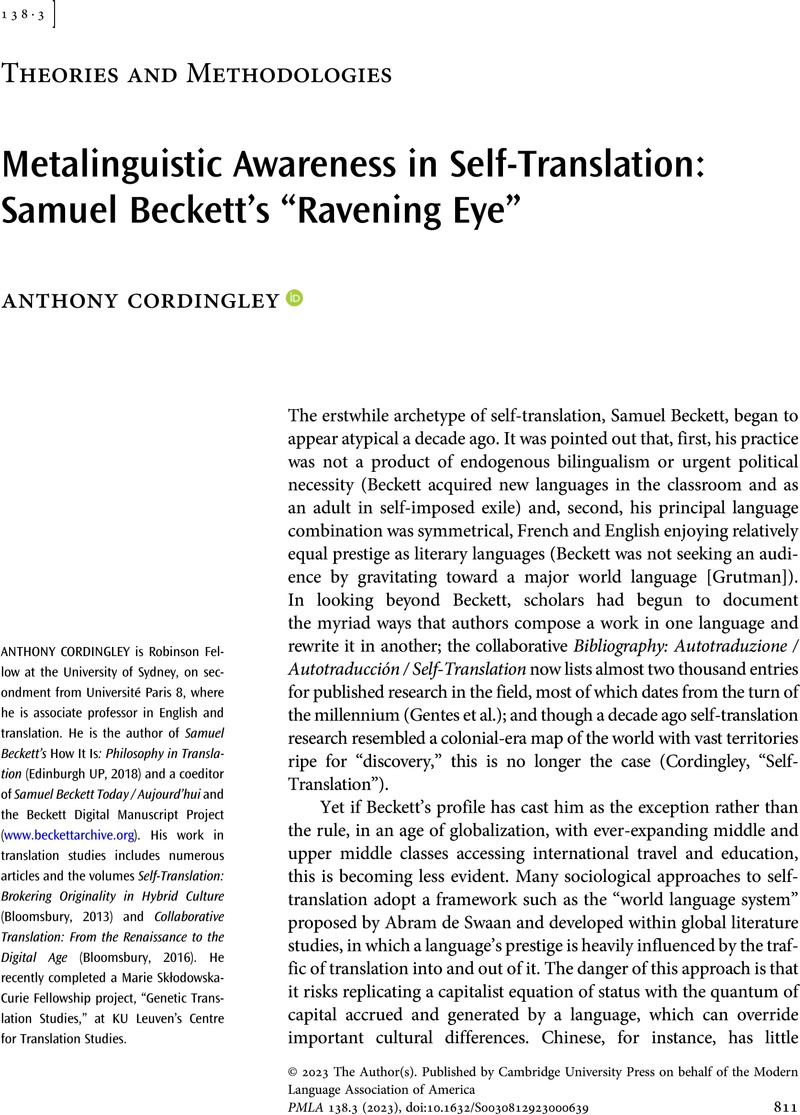No CrossRef data available.
Article contents
Metalinguistic Awareness in Self-Translation: Samuel Beckett's “Ravening Eye”
Published online by Cambridge University Press: 12 September 2023
Abstract
An abstract is not available for this content so a preview has been provided. Please use the Get access link above for information on how to access this content.

- Type
- Theories and Methodologies
- Information
- Copyright
- Copyright © 2023 The Author(s). Published by Cambridge University Press on behalf of the Modern Language Association of America
References
Works Cited
Ackerley, Chris. “Samuel Beckett and Thomas à Kempis: The Roots of Quietism.” Samuel Beckett Today/Aujourd'hui, vol. 9, 2000, pp. 81–92.Google Scholar
Barré, Germain. “La ‘mondialisation’ de la culture et la question de la diversité culturelle: Étude des flux mondiaux de traductions entre 1979 et 2002.” Revista hispana para el análisis de redes sociales, vol. 18, no. 8, 2010, pp. 183–217.Google Scholar
Beckett, Samuel. “Le Calmant.” Nouvelles et textes pour rien, Minuit, 1991, pp. 41–75.Google Scholar
Beckett, Samuel. Comment c'est / How It Is and / et L'Image: A Critical-Genetic Edition / Une édition critico-génétique. Edited by O'Reilly, Édouard Magessa, Routledge, 2001.Google Scholar
Beckett, Samuel. The Complete Short Prose, 1929–1989. Edited by Gontarski, S. E., Grove, 1995.Google Scholar
Beckett, Samuel. Letter to Axel Kaun. 9 July 1937. The Letters of Samuel Beckett, vol. 1 (1929–40), edited by Fehsenfeld, Martha Dow et al., Cambridge UP, 2009, pp. 512–22.Google Scholar
Beckett, Samuel. Letter to Hans Naumann. 17 Feb. 1954. The Letters of Samuel Beckett, vol. 2 (1941–56), edited by Craig, George et al., Cambridge UP, 2011, pp. 460–65.Google Scholar
Beckett, Samuel. Letter to Barbara Bray. 11 Mar. 1959. The Letters of Samuel Beckett, vol. 3 (1957–65), edited by Craig, George et al., Cambridge UP, 2015, pp. 210–12.Google Scholar
Beckett, Samuel. “Samuel Beckett's Notes to His Reading of the Ethics by Arnold Geulincx.” Geulincx, pp. 311–53.Google Scholar
Cordingley, Anthony. Samuel Beckett's How It Is: Philosophy in Translation. Edinburgh UP, 2018.Google Scholar
Cordingley, Anthony. “Self-Translation.” The Cambridge Handbook of Translation, edited by Malmkjær, Kirsten, Cambridge UP, 2022, pp. 75–95.Google Scholar
Cordingley, Anthony, and Stenberg, Josh. “Collaboration and the Modern Chinese-Language Self-Translator.” Translation Quarterly, no. 100, 2021, pp. 87–110.Google Scholar
Cordingley, Anthony, and Stenberg, Josh. Self-Translation and the Modern Chinese Literary World. Palgrave Macmillan, 2024.Google Scholar
Gentes, Eva, et al., editors. Bibliography: Autotraduzione / Autotraducción / Self-Translation. 41st ed., May 2022, app.box.com/s/w398666a7hmbittnf97jlyr2k1je7zg0.Google Scholar
Geulincx, Arnold. Ethics, with Samuel Beckett's Notes. Translated by Wilson, Martin, edited by Van Ruler, Han et al., Brill, 2006.Google Scholar
Grutman, Rainier. “A Sociological Glance at Self-Translation and Self-Translators.” Self-Translation: Brokering Originality in Hybrid Culture, edited by Cordingley, Anthony, Bloomsbury, 2013, pp. 63–80.Google Scholar
Hu, Guangwei. “The Misleading Academic Discourse on Chinese-English Bilingual Education in China.” Review of Educational Research, vol. 78, no. 2, 2008, pp. 195–231, https://doi.org/10.3102/0034654307313406.CrossRefGoogle Scholar
Lennon, Brian. In Babel's Shadow: Multilingual Literatures, Monolingual States. U of Minnesota P, 2010.CrossRefGoogle Scholar
Sardin-Damestoy, Pascal. Samuel Beckett auto-traducteur ou l'art de ‘l'empêchement.’ PU d'Artois, 2002.CrossRefGoogle Scholar
Scheinner, Corinne. “Self-Translation.” Samuel Beckett in Context, edited by Uhlmann, Anthony, Cambridge UP, 2013, pp. 370–80.Google Scholar
Shih, Shu-mei. “The Concept of the Sinophone.” PMLA, vol. 126, no. 3, May 2011, pp. 709–18, https://doi.org/10.1632/pmla.2011.126.3.709.Google Scholar
Walkowitz, Rebecca L. “On Not Knowing: Lahiri, Tawada, Ishiguro.” New Literary History, vol. 51, no. 2, 2020, pp. 323–46.Google Scholar
Wanner, Adrian. Out of Russia: Fictions of a New Translingual Diaspora. U of Minnesota P, 2011.Google Scholar
“What Is the Most Spoken Language?” Ethnologue, www.ethnologue.com/insights/most-spoken-language/. Accessed 24 Mar. 2023.Google Scholar




